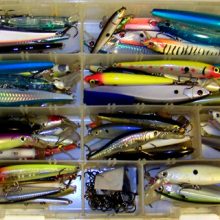This article may contain affiliate links. If you make a purchase after clicking on a link we may earn a small commission at no extra cost to you. As an Amazon Associate, I earn from qualifying purchases.
Crankbait vs Jerkbait – What’s the Difference?

Most bass anglers will keep a large selection of both crankbaits and jerkbaits in their tackle boxes, both can absolutely slay large bass when the conditions are right.
But, what exactly is the difference between crankbaits and jerkbaits?
Crankbaits generally have a shorter fatter body shape and a variety of different styles of diving bill, whereas a jerkbait will have a longer more slender body.
Crankbaits are usually used most in summer months and jerkbaits in winter months but this is not a hard and fast rule.
Crankbait vs Jerkbait
Crankbaits have a shorter, stubbier body shape, will generally only have two treble hooks while a jerkbait on the other-hand will be longer and more slender and can have up to three treble hooks.
Depending on the season and water conditions how you fish a jerkbait will vary as too will a crankbait.
However, jerkbaits are generally fished with a lot more action added by ‘jerking’ or twitching the rod tip and then pausing.
Crankbaits can also be fished in this style but they are more often than not cast along or near some kind of structure and retrieved in a more regular fashion.
Crankbaits are also a popular choice for trolling with as there running depth can be easily controlled by either the speed the boat is running at or the use of a downrigger.
Body Types
As mentioned above the body of a jerkbait will normally be longer and thinner than a crankbait.
Traditionally both would have been made out of balsa wood.
These days however, manufacturers have switched to using hard plastic more and more for jerkbaits but for crankbaits there is still a lot that are made from balsa wood.
Running Depth
When comparing jerkbaits and crankbaits most anglers would say that a crankbait will run deeper than a jerkbait due to the larger dive bills that crankbaits can have.
However, things aren’t always that simple. You can get sinking jerkbaits and these will run deeper than a floating crankbait.
When you compare the two types of lures that have a neutral bouancy the suspending jerkbait will in fact running more shallow than the average crankbait.
Jerkbaits are fished with a pause, and if you are using a floating model then that pause can allow the lure to float back to the surface slowly so because of this jerkbaits can be used in the top three feet of the water column much easier than a crankbait.
Diving Bills
The dive bills on a jerkbait are generally of the same size and shape across most different models.
On a crankbait there are various sizes and shapes. How deep the lures will run will vary by both the size, shape and by how aggressively down-turned the dive bill is.
The dive bill and shorter body on a crankbait will also give it a more aggressive swim action than a jerkbait.
Hooks
The fact that jerkbaits are longer on average than a crankbait means that on larger models they will usually have three treble hooks as apposed to the more regular two on a crankbait.
A lot of anglers like to switch out the stock hooks for higher quality hooks, you need to be careful when doing this as replacing the manufacturers hooks with heavier after market hooks can affect the swim characteristics of both jerkbaits and crankbaits.
Tackle Differences
Most fishermen will run slightly different setups when using a jerkbait or a crankbait.
For example on an average jerbait setup your typical jerkbait fishing rod will have a faster action than a crankbait rod to allow for the fact that you twitch the lure to add some life into it.
Whilst monofilament is normally favored for crankbaits the go to fishing line for jerkbaits will be fluorocarbon due to it’s lower stretch and lower visibility.
